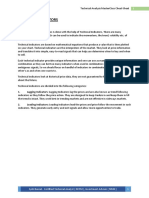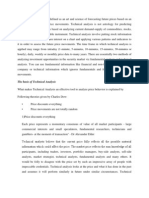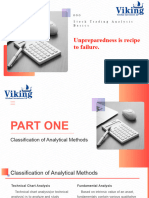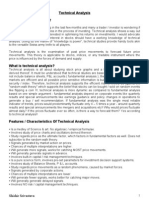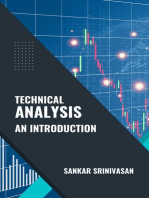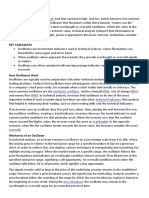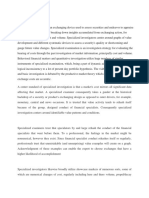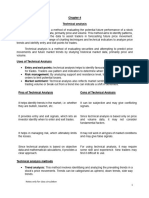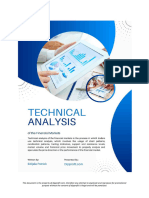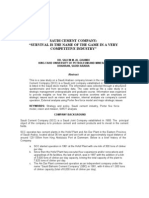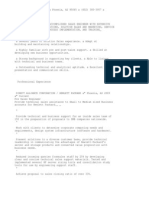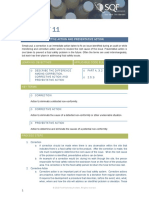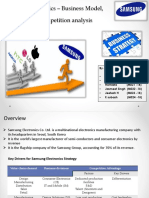Saim
Saim
Uploaded by
Nishtha SethCopyright:
Available Formats
Saim
Saim
Uploaded by
Nishtha SethOriginal Description:
Original Title
Copyright
Available Formats
Share this document
Did you find this document useful?
Is this content inappropriate?
Copyright:
Available Formats
Saim
Saim
Uploaded by
Nishtha SethCopyright:
Available Formats
Assignment
a Technical analysis is based on the assumption that markets are driven more by psychological factors than fundamental values. Substantiate. Ans. Technical analysis is based on the assumption that marke t s a r e d r i v e n m o r e b y psychological factors than fundamental
values. Its proponents believe that asset prices reflect not only the underlying value of the assets but also the hopes and fears of those in the market. They assume that the emotional makeup of investors does not change, that in a certain set of circumstances, investors will react in a similar manner to how they did in the past and that the resultant price moves are likely to be the same. Technical analysts use chart patterns to analyze market movements and to predict security prices. Although many of these charts have been used for more than 100 years, technical analysis believe them to be relevant even now, as they illustrate patterns in price movements that often repeat themselves. Technical analysis can be applied to any security which has historical trading data. This includes stocks, bonds, futures, foreign exchange etc. In this unit, we will give examples of stocks but remember that the technical analysis can be used for any type of security. Tools of Technical Analysis There are many different types of technical traders: some rely on chart patterns, others use technical indicators and oscillators, and most use some combination of the two.
Charting: Technical analysts are sometimes called chartists because they study records or charts of past stock prices and trading volume, hoping to find patterns they can exploit to make a profit. Technical Indicators: Technical analysts also use technical indicators besides charts to assess prospects for market declines or advances. A technical indicator is a series of data points that are derived by applying a formula to the price data of a security. Price data includes any combination of the open, high, low or close over a period of time. Technical indicators can be classified in a number of ways. One classification divides them into three types: sentiment indicators, flow of funds indicators, and market structure indicators. Sentiment indicators are intended to measure the expectations o f v a r i o u s g r o u p s o f investors, for example, mutual fund investors, and corporate insiders. Flow of funds indicators are intended to measure the potential for various investor groups to buy or sell stocks in order to predict the price pressure for those actions. Market structure indicators monitor price trends and cycles
b. What are technical indicators and how it is useful to a technical analyst? Ans. A technical indicator is a series of data points that are derived by applying a formula to the price and/or volume data of a security. Price data can be any combination of the open, h i g h , l o w o r c l o s i n g p r i c e o v e r a p e r i o d o f t i m e . S o m e i n d i c a t o r s m a y u s e o n l y t h e closing prices, while others incorporate volume and open interest into their formulae. The price data is entered into the formula and a data point is produced. For
example, say the closing prices of a stock for 3 days are Rs. 41, Rs.43 and Rs43. If a technical indicator is constructed using the average of the closing prices, then the average of the 3 closing is o n e data point
(41+43+43)/3=42.33). However, one data point does not offer m u c h information. A series of data points over a period of time is required to enable analysis. Thus we can have a period moving average as a technical indicator where we drop the earliest closing price and use the next closing price for calculations. By, creating a time series of data points, a comparison can then be made between present and past levels. Technical indicators are usually shown in a graphical form above or below a security price chart for facilitating analysis. Once shown in graphical form, an indicator can then be compared with the corresponding price chart of the security. Some times indicators are plotted on top of the price plot for a more direct comparison. Technical indicators measure money flow, trends, volatility and momentum etc. They are used for two main purposes: to confirm price movement and the quality of chart patterns, and to form buy and sell signals. A technical indicator offers a different perspective from w h i c h t o a n a l y z e t h e p r i c e action. Some, such as moving averages, are derived from simple formulae and they are relatively easy to understand. Others, like stochastic have complex formulae and require more effort to fully understand and appreciate. Technical indicators can provide unique perspective on the strength and direction of the underlying price action. Indicators filter price action with formulae. Therefore they are derivative measures and
not direct reflections of theprice action. T h i s s h o u l d b e t a k e n i n t o a c c o u n t w h e n analyzing the indicators. Any analysis of an indicator should be taken with the price action in
mind. There are two main types of indicators: leading and lagging. A leading indicator precedes price movements; therefore they are used for predication. A lagging indicator follows price movement and therefore is a confirmation. The main benefit of leading indicators is that they provide early signaling for entry and exit. Early signals can forewarn against a potential strength or weakness. Leading indicators can be used in trending markets. In a market that is trending up, the leading indicator helps identify oversold conditions for buying opportunities. In a market that is trending down, leading indicators can help identify overbought situations for selling opportunities. include Some of the more strength
popular leading indicators
Relative
Index (RSI) and Stochastic Oscillator Lagging indicators follow theprice action and are commonly ref e r r e d t o a s trend-following i n d i c a t o r s . Lagging indicators work best when the markets or securities develop strong trends. They are designed to get traders in and keep them in as long as the trend in intact. As such, these indicators are not effective in trading or sideways markets. Some popular trend-following indicators include moving averages and Moving Average Convergence Divergence (MACD).Technical indicators are constructed in two ways: those that fall in a bounded range andt h o s e t h a t d o n o t . T e c h n i c a l i n d i c a t o r s t h a t a r e b o u n d w i t h i n a r a n g e a r e c a l l e d oscillators. Oscillators are used as an overbought/oversold indicator. A market is said to be overbought when prices have been trending higher in a relatively steep fashion for some time, significantly outweighs those on the
sidelines or holding short positions. T h i s m e a n s t h a t t h e r e a r e fewer participants to jump onto the back of the trend. The oversold condition is just the opposite. The market has been trending lower for sometime and is running out of fuel for further price declines. Oscillator indicators move within have a range, say between zero and 100, and signal periods where the security is overbought (near 100) or oversold (near zero). Oscillators are the most common type of technical indicators. The technical indicators that are not bound within a range also form buy and sell signals and display strength or weakness in the market, but they can vary in the way they do this. T h e t w o m a i n w a y s t h a t technical indicators are used to form buy and sell signals isthrough crossovers and divergence. Crossovers occur when eit h e r t h e p r i c e m o v e s through the moving average, or when two
different moving averages cross over each other. Divergence happens when the direction of the price trend and the direction of the indicator trend are moving in the opposite direction. This indicates that the direction of the price trend is weakening. Technical indictors provide an extremely useful source of additional information.
Thesei n d i c a t o r s h e l p i d e n t i f y m o m e n t u m , t r e n d s , v o l a t i l i t y a n d v a r i o u s o t h e r a s p e c t s i n a security to aid in the technical analysis of trends. While some traders just use a single indicator for buy and sell signals, it is best to use them along with price movement, chart patterns and other indicators.A n u m b e r o f t e c h n i c a l i n d i c a t o r s a r e i n u s e . S o m e o f t h e t e c h n i c a l i n d i c a t o r s a r e discussed below for the purpose of illustration of the concept. Moving average
The moving average is a lagging indicator which is easy to construct and is one of the most widely used. A moving average, as the name suggests, represents an average of a certain series of data that moves through time. The most common way to calculate the moving average is to work from the last 10 days of closing prices. Each day, the most recent close (days 11) is added to the total and the oldest close (day 1) is subtracted. The n e w t o t a l i s t h e n d i v i d e d b y t h e t o t a l n u m b e r o f d a y s ( 1 0 ) a n d t h e r e s u l t a n t a v e r a g e computed. The purpose of the moving average is to track the progress of a price trend. The moving average is a smoothing device. By averaging the data, a smoother line is produced, making it much easier to view the underlying trend. A moving average filters out random noise and offers a smoother perspective of the price action. Moving Average Convergence Divergence (MACD) MACD is a momentum indicator and it is made up of two exponential moving averages. The MACD plots the difference between a 26-day exponential moving average and a 12-day exponential moving average. A 9-day moving average is generally used as a trigger line. When the MACD crosses this trigger and goes down it is a bearish signal and wheni t c r o s s e s i t t o g o a b o v e i t , i t s b u l l i s h s i g n a l . T h i s i n d i c a t o r m e a s u r e s s h o r t - t e r m momentum as compared to longer term
momentum and signals the current direction of momentum. Traders use the MACD for indicting trend reversals. Relative Strength Index The relative strength index (RSI) is another of the well known momentum indicators. Momentum measures the rate of change of prices by continually taking price differences for a fixed time interval. RSI helps to
signal overbought and oversold conditions in a security. RSI is plotted in a range of 0-100. A reading above 70 suggests that a security is overbought, while a reading below 30 suggests that it is oversold. This ind icator help traders to identify whether a securitys price has been unreasonably pushed to its current levels and whether a reversal may be on the way. Stochastic Oscillator The stochastic Oscillator is one of the most recognized moment u m i n d i c a t o r s . T h i s indicator provides information about the location of a current closing price in relation to the periods high and low prices. The closer the closing price is to the periods high, the higher is the buying pressure, and the closer the closing price is to the periods low, the move is the selling pressure. The idea behind this indicator is that in an uptrend, the price should be closing near the highs of the trading range, signaling upward momentum in the security. In downtrends, the price should be closing n ear the lows of the trading range, signaling downward momentum. The stochastic oscillator is plotted within a range of zero and 100 and signals overbought conditions above 80 and oversold conditions below20
You might also like
- Technical Analysis MasterClass CheatSheet PDFDocument14 pagesTechnical Analysis MasterClass CheatSheet PDFAman KumarNo ratings yet
- Project On Technical AnalysisDocument82 pagesProject On Technical Analysistulasinad12375% (8)
- Beginner's Guide To Technical & Fundamental AnalysisDocument31 pagesBeginner's Guide To Technical & Fundamental AnalysisAkshit Khanijo100% (2)
- The Basis of Technical AnalysisDocument7 pagesThe Basis of Technical AnalysisFranklin Aleyamma JoseNo ratings yet
- Securities Analysis and Portfolio Management: Prices Usually Always Move in TrendsDocument8 pagesSecurities Analysis and Portfolio Management: Prices Usually Always Move in TrendsStuti Jain100% (1)
- The Only Technical Analysis Book - Brian Hale - Part 4Document10 pagesThe Only Technical Analysis Book - Brian Hale - Part 4YapKJNo ratings yet
- Gautam BlackbookDocument93 pagesGautam BlackbookRio duttNo ratings yet
- Technical AnalysisDocument36 pagesTechnical AnalysisDivya GøwdaNo ratings yet
- 7 Technical Indicators To Build A Trading ToolkitDocument26 pages7 Technical Indicators To Build A Trading ToolkitsunilvermabitspilaniNo ratings yet
- Technical AnalysisDocument9 pagesTechnical AnalysisHimanshu MishraNo ratings yet
- Kani ProjectDocument68 pagesKani Projectkoshi vedaNo ratings yet
- Gautam Final BlackcookDocument82 pagesGautam Final BlackcookRio duttNo ratings yet
- Technical AnalysisDocument43 pagesTechnical AnalysisSuvasmita BiswalNo ratings yet
- History of Technical AnalysisDocument23 pagesHistory of Technical AnalysisShubham BhatiaNo ratings yet
- 10besttechnicalindicatorslisttrendindicators 240128171559 d601c96dDocument14 pages10besttechnicalindicatorslisttrendindicators 240128171559 d601c96dDipun KumarNo ratings yet
- 3.2technical AnalysisDocument41 pages3.2technical Analysisjuntupallirohitkumar2000No ratings yet
- Technical Analysis #Document158 pagesTechnical Analysis #rachitcreativeNo ratings yet
- Research MethodologyDocument5 pagesResearch Methodologysonal gargNo ratings yet
- Trading Indicators FinasticDocument27 pagesTrading Indicators FinasticbullscrownfxNo ratings yet
- Stock Trading Analysis BasicsDocument20 pagesStock Trading Analysis Basicspav547No ratings yet
- Technical Analysis Why Technical Analysis?: Shishir SrivastavaDocument12 pagesTechnical Analysis Why Technical Analysis?: Shishir SrivastavaShishir Srivastava100% (1)
- Shruti Jain Smart Task 02Document7 pagesShruti Jain Smart Task 02shruti jainNo ratings yet
- Technical AnalysisDocument36 pagesTechnical AnalysisjertinNo ratings yet
- Technical AnalysisDocument31 pagesTechnical AnalysisAnonymous KN4pnOHmNo ratings yet
- Market and Momentum Oscillators: Andres Aguilar Daniela Iporre Carla Sanchez Teresa Ruiz Ricardo ZarateDocument5 pagesMarket and Momentum Oscillators: Andres Aguilar Daniela Iporre Carla Sanchez Teresa Ruiz Ricardo ZarateAndres Aguilar JemioNo ratings yet
- Technical AnalysisDocument4 pagesTechnical AnalysisBipasha RayNo ratings yet
- Introduction To Technical A AnalysisDocument2 pagesIntroduction To Technical A AnalysisVedant MahajanNo ratings yet
- What Is Technical AnalysisDocument5 pagesWhat Is Technical AnalysisblezylNo ratings yet
- Fundamental and Technical Analysis - Technical PaperDocument16 pagesFundamental and Technical Analysis - Technical PaperGauree AravkarNo ratings yet
- Indicator Soup: Enhance Your Technical Trading - September 2007 - by Darrell JobmanDocument5 pagesIndicator Soup: Enhance Your Technical Trading - September 2007 - by Darrell JobmanLuisa HynesNo ratings yet
- Stock Market Indicators Cheat SheetDocument17 pagesStock Market Indicators Cheat Sheetvikubhardwaj9224No ratings yet
- What Is The Forex Technical Analysis?Document37 pagesWhat Is The Forex Technical Analysis?funny079No ratings yet
- Technical AnalysisDocument11 pagesTechnical AnalysisAachal JaiswalNo ratings yet
- Technical Analysis For The Mathematical MindDocument1 pageTechnical Analysis For The Mathematical MindF WilliamsNo ratings yet
- Basic of Technical AnalysisDocument44 pagesBasic of Technical Analysissameer jadhavNo ratings yet
- Fundamental Analysis Technical Analysis Chartists: Why Does It Happen?Document3 pagesFundamental Analysis Technical Analysis Chartists: Why Does It Happen?noniiiiNo ratings yet
- The PalmDocument45 pagesThe PalmDarren_1986No ratings yet
- Technical AnalysisDocument5 pagesTechnical AnalysisNiño Rey LopezNo ratings yet
- Oscillator PDFDocument2 pagesOscillator PDFSandeep MishraNo ratings yet
- Priyanka IntroDocument8 pagesPriyanka IntroSameer KambleNo ratings yet
- Introduction To Stock Chart PatternsDocument15 pagesIntroduction To Stock Chart PatternsMichael Yang TangNo ratings yet
- Chapter - IDocument50 pagesChapter - IshahimermaidNo ratings yet
- Technical Analysis BY P. SAI PRATHYUSHADocument6 pagesTechnical Analysis BY P. SAI PRATHYUSHAP.sai.prathyushaNo ratings yet
- Chapter 4 Technical AnalysisDocument26 pagesChapter 4 Technical Analysisdafibal143No ratings yet
- What Is Technical Analysis?Document3 pagesWhat Is Technical Analysis?Jonhmark AniñonNo ratings yet
- Technical AnalysisDocument13 pagesTechnical Analysispradeepanarayana2002No ratings yet
- Academy Binance Com en Articles What Is Technical AnalysisDocument5 pagesAcademy Binance Com en Articles What Is Technical AnalysisvivopanguNo ratings yet
- 3.introduction Technical AnalysisDocument13 pages3.introduction Technical AnalysisJohn JonakosNo ratings yet
- Technical Analysis of The Financial MarketsDocument26 pagesTechnical Analysis of The Financial Marketsmcjn.commercialNo ratings yet
- MF0001Document19 pagesMF0001Brijesh SalianNo ratings yet
- Technical and Fundamental AnalysisDocument5 pagesTechnical and Fundamental AnalysisTapan RathNo ratings yet
- License To TradeDocument15 pagesLicense To Tradepab888345No ratings yet
- The Ultimate Indicators For Crypto TradingDocument8 pagesThe Ultimate Indicators For Crypto TradingUgo BenNo ratings yet
- 17.forecasting of Forex Market Using Technical AnalysisDocument65 pages17.forecasting of Forex Market Using Technical Analysisharrydeepak100% (1)
- StochasticDocument8 pagesStochastics221091638No ratings yet
- Technical Analysis LecturesDocument4 pagesTechnical Analysis LecturesMuhammad bilalNo ratings yet
- TECHNICAL ANALYSIS FOR BEGINNERS: A Beginner's Guide to Mastering Technical Analysis (2024 Crash Course)From EverandTECHNICAL ANALYSIS FOR BEGINNERS: A Beginner's Guide to Mastering Technical Analysis (2024 Crash Course)No ratings yet
- The Complete Guide to Chart Reading: Techniques for Successful Trading Across MarketsFrom EverandThe Complete Guide to Chart Reading: Techniques for Successful Trading Across MarketsNo ratings yet
- Chapter 15 Alternative Corporate Restructuring StrategiesDocument7 pagesChapter 15 Alternative Corporate Restructuring StrategiesNishtha SethNo ratings yet
- Introduction To BI, Decision Support SystemsDocument123 pagesIntroduction To BI, Decision Support SystemsNishtha SethNo ratings yet
- ACN Research AssignmentsDocument5 pagesACN Research AssignmentsNishtha SethNo ratings yet
- Bia Unit-3 Part-3Document78 pagesBia Unit-3 Part-3Nishtha Seth100% (1)
- Barriers in International BusinessDocument8 pagesBarriers in International BusinessNishtha SethNo ratings yet
- Human Resource Management: Made By: Deepesh Arya 06980303913 (2ND SEMESTER) Mba (E) - ADocument16 pagesHuman Resource Management: Made By: Deepesh Arya 06980303913 (2ND SEMESTER) Mba (E) - ANishtha SethNo ratings yet
- Human Resource Management: Made By: Supriya Verma 07080303913 (2ND SEMESTER) Mba (E) - ADocument16 pagesHuman Resource Management: Made By: Supriya Verma 07080303913 (2ND SEMESTER) Mba (E) - ANishtha SethNo ratings yet
- Swiss Exchange (Formerly SWX Swiss Exchange) ,: Ans. Shenzhen SZSE and Hong Kong SEHKDocument2 pagesSwiss Exchange (Formerly SWX Swiss Exchange) ,: Ans. Shenzhen SZSE and Hong Kong SEHKNishtha SethNo ratings yet
- SAIMDocument6 pagesSAIMNishtha SethNo ratings yet
- Assignment: Q1. How Are Mutual Funds Regulated?Document4 pagesAssignment: Q1. How Are Mutual Funds Regulated?Nishtha SethNo ratings yet
- International Finanical ManagementDocument2 pagesInternational Finanical ManagementNishtha SethNo ratings yet
- Agency and Partnership - UST Civil Law NotesDocument67 pagesAgency and Partnership - UST Civil Law NotesREINE JULIA SORIANO MADRIAGANo ratings yet
- Cfas Quiz 2Document8 pagesCfas Quiz 2Glen Mervin EsguerraNo ratings yet
- Decision To Advertise: Remember - Keep Cost To A Minimum!Document1 pageDecision To Advertise: Remember - Keep Cost To A Minimum!vishal9patel-63No ratings yet
- CCG ConsultantDocument2 pagesCCG ConsultantHimanshu BohraNo ratings yet
- Social Media For Business Owners and ManagersDocument2 pagesSocial Media For Business Owners and ManagersGhi zlaneNo ratings yet
- Unified HSE Passport FrameworkDocument52 pagesUnified HSE Passport FrameworkIMSATT HSENo ratings yet
- (Eng) SAMPLE Xangle Credit Rating PDFDocument4 pages(Eng) SAMPLE Xangle Credit Rating PDFEdwin OngNo ratings yet
- Extra Work Hours ApprovalDocument3 pagesExtra Work Hours ApprovalEwoirNo ratings yet
- The Six Big Losses in Manufacturing - EvoconDocument23 pagesThe Six Big Losses in Manufacturing - Evoconarvin john cabralNo ratings yet
- Bachelor Course Offer 2018-2019 (IBBA KEDGE Bachelor) MRSDocument2 pagesBachelor Course Offer 2018-2019 (IBBA KEDGE Bachelor) MRSretrewegweNo ratings yet
- Saudi Cement RevisedDocument13 pagesSaudi Cement RevisedSonu AgrawalNo ratings yet
- Corporate Citizenship: Hasnain - Ahad - Aiman - RaheelDocument32 pagesCorporate Citizenship: Hasnain - Ahad - Aiman - RaheelDaniyalHaider100% (1)
- Pre-Sales Engineer / Solution ArchitectDocument4 pagesPre-Sales Engineer / Solution Architectapi-78315843No ratings yet
- Answer - Audit Planning - Lab Manual 1Document2 pagesAnswer - Audit Planning - Lab Manual 1Naresh Batra AssociatesNo ratings yet
- Product Comparison Chart: SalesDocument4 pagesProduct Comparison Chart: SalesSivakumar BakthavachalamNo ratings yet
- Accion Labs Test Program Manager, SingaporeDocument2 pagesAccion Labs Test Program Manager, SingaporegopualakrishnanNo ratings yet
- Forward ContractsDocument31 pagesForward ContractsDeepthi Ravichandhran100% (1)
- Tip Sheet 11 Correction Corrective Action and Preventative ActionDocument2 pagesTip Sheet 11 Correction Corrective Action and Preventative Actionelflaquito80No ratings yet
- Pillas 02activity1 StrategicManagementDocument2 pagesPillas 02activity1 StrategicManagementKrisy CielNo ratings yet
- Samsung Electronics - Business Model, Strategy and Competition AnalysisDocument12 pagesSamsung Electronics - Business Model, Strategy and Competition AnalysisHemlata ChoudharyNo ratings yet
- 19.arguments For and Against ProtectionismDocument4 pages19.arguments For and Against ProtectionismYumna ShakirNo ratings yet
- Gross List 08/09/2022 - 08/09/2022: All Sheriff Sales Are Buyer BewareDocument16 pagesGross List 08/09/2022 - 08/09/2022: All Sheriff Sales Are Buyer Bewarejon longNo ratings yet
- 6-Astore 20190424 113509Document3,060 pages6-Astore 20190424 113509Niomi GolraiNo ratings yet
- 93 Production 51 Accounting AccountingDocument11 pages93 Production 51 Accounting AccountinganasirrrNo ratings yet
- CV Andrea Yanez M. 2022Document1 pageCV Andrea Yanez M. 2022Daniel MoranNo ratings yet
- SAP BarcodeDocument2 pagesSAP BarcodeSaad JavedNo ratings yet
- Manual For Procurement of Consultancy and Other Services - 0Document110 pagesManual For Procurement of Consultancy and Other Services - 0manna.dass76No ratings yet
- c36 Form PDFDocument2 pagesc36 Form PDFDavidNo ratings yet
- Due Dligence Checklist (1) - IPODocument39 pagesDue Dligence Checklist (1) - IPORajkumar KvmNo ratings yet
- BERJAYA Kamalia Rasyidah Binti Sufyan - 25621 - 0Document19 pagesBERJAYA Kamalia Rasyidah Binti Sufyan - 25621 - 0kamalia fathanahNo ratings yet
